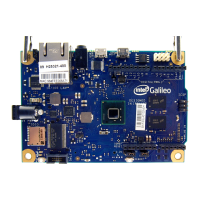Intel
®
Galileo
March 2014 Board User Guide
Order Number: 330237-001US 17
Communication and Programming—Intel
®
Galileo Board
3.2 Programming
Use the Arduino Software Development Environment to create programs, called
sketches, for the Intel
®
Galileo Board. To run a sketch on the board:
1. Connect a power supply.
2. Connect the board’s USB client port to a computer.
3. Upload the sketch using the IDE interface.
The sketch runs on the Intel
®
Galileo Board and communicates with the Linux* kernel
in the board’s firmware using the Arduino I/O adapter. For complete details on
programming your board, see the Intel
®
Galileo Board Getting Started Guide (Table 4).
When the board boots up, two scenarios are possible:
• If a sketch is present in persistent storage, it is executed.
• If no sketch present, the board waits for upload commands from the IDE.
If a sketch is executing, you can upload from the IDE without having to press the reset
button on the board. The sketch is stopped; the IDE waits for the upload state, and
then starts the newly uploaded sketch.
Pressing the reset button on the board restarts a sketch if it is executing and resets any
attached shields.
3.3 Automatic (Software) Reset
Rather than requiring a physical press of the reset button before an upload, the Intel
®
Galileo Board is designed in a way that allows it to be reset by software running on a
connected computer. USB CDC-ACM control signals are used to transition the board
from run-time to bootloader mode. The Arduino software uses this capability to allow
you to upload code by simply pressing the upload button in the Arduino environment.
For details, see the Intel
®
Galileo Board Getting Started Guide (Table 4).

